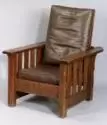When The Simple Life Becomes The Obsessive Life

There’s nothing like an unmarked piece of Arts and Crafts furniture to send me on a little journey.
Once again.
This time I was going to inspect what appeared to possibly be either a Gustav Stickley or an L. & J.G. Stickley flat arm Morris chair, one of my favorite forms and a classic among Arts and Crafts furniture designs. So it was worth driving to see.
It was described as being unmarked, which can often mean (1.) it has been refinished, (2.) the seller did not know where to look for a shopmark, (3.) the seller could not recognize a fragment of a shopmark, or (4.) it was a piece of junk, a knock-off, or a manual arts school project.
Less often it means it slipped out of the factory on Friday afternoon when the kid assigned to sticking on labels was goofing off with one of his buddies on the loading dock. “The boss will never know,” he mutters belatedly, as he watches the men close the door to the packed railcar.
In this case what was possibly Stickley turned out to be by a different company with strong ties to the Stickley family. The firm of J. M. Young & Sons produced a respectable line of Arts and Crafts furniture longer than any of the Stickley men. Many of their designs were either borrowed from or based upon those of Gustav or L. & J.G. Stickley, a fact that must have irritated them at times. In the 1920s, when Leopold Stickley decided to drop Arts and Crafts in favor of a line of colonial reproductions, he sent their furniture patterns, finish formulas, and customers to J. M. Young & Sons, who continued making Arts and Crafts furniture into the 1940s.
The Youngs marked their furniture with a fragile paper label, which often disappears over time. If you are ever standing in front of an unmarked, flat arm Morris chair that looks a lot like those well-publicized versions by any of the Stickleys, here are a few design characteristics that may identify the chair as being the Young family’s model #186. Keep in mind there are exceptions to every rule.
– the adjustable back will be supported by a wooden bar;
– the adjustable back will pivot on two metal hinges rather than wooden pins;
– there will be four slats under the arms rather than five;
– the pegs will be ¼” diameter rather than 3/8″;
– the bottoms of the legs will have holes for castors;
– the corbels will be nailed rather than pegged to the legs;
– the exposed tenons on the tops of the arms will be false tenons;
– the exposed tenons on the sides of the legs will not be beveled.
Boy, can we be any more obsessive?
(And for those of you who are now thinking, “This poor guy needs to get a life,” the sad fact is, “This is my life.”)

Until next Monday,
Have a less obsessive life than mine!
Bruce
Coming Soon: The list of topics and speakers for the 27th National Arts and Crafts Conference at the Grove Park Inn on February 21-23. Watch for it here!
